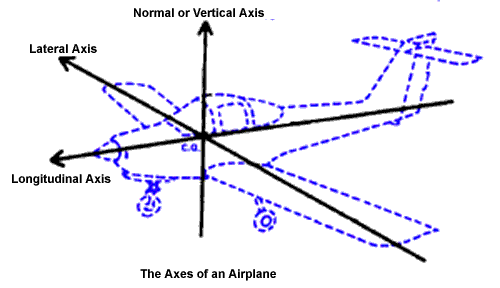Aircraft Flight Controls: Basic Guide for Pilot Students
Embarking on a journey to become a pilot is thrilling, and understanding flight controls is a cornerstone of pilot training. This article aims to demystify the primary flight controls and their intricacies for aviation students. It covers the nuances of how these controls influence an aircraft's Behaviour in the air and the importance of mastering them for safe and efficient flying.
The control of an aircraft in the sky is a complex yet fascinating aspect of flying. Whether it's cruising, ascending, descending, or navigating turns, the pilot's manipulation of the flight controls dictates the aircraft's response. Understanding the primary flight controls is essential for every aspiring aviator.
Primary Flight Controls: Elevators, Ailerons, and Rudder
Lateral, Longitudinal, and Normal or Vertical axis
Elevator - The Pitch Controller
The elevator, positioned on the tailplane's trailing edge, is pivotal in controlling the aircraft's pitch. It moves the nose up or down in response to the pilot's input.
The pilot operates the elevator using fore and aft movements of the control column or wheel, directly influencing the aircraft's ascent or descent.
Ailerons - Masters of the Roll
Located on the outer trailing edges of the wings, ailerons are crucial for controlling the aircraft's roll. They enable the aircraft to tilt and bank during turns.
Pilots manipulate the ailerons by rotating the control wheel or moving the control stick sideways, facilitating smooth turns and level flight adjustments.
Rudder - The Yaw Adjuster
The rudder, attached to the trailing edge of the fin, plays a critical role in controlling the aircraft's yaw. It steers the nose left or right.
Pilots use rudder pedals to manage yaw, ensuring directional stability and aiding in coordinated turns.
Understanding Aircraft Attitude and Axes
The aircraft's attitude, its orientation relative to the horizon, is a fundamental concept in flying. It involves understanding the three axes of rotation: lateral (pitch), longitudinal (roll), and normal (yaw).
Mastery of these axes and the corresponding controls is vital for pilots to maintain desired flight paths and handle various flight scenarios.
Achieving and Managing Flight Control
Pilots use external references, primarily the horizon, to establish the aircraft's attitude. Once a stable attitude is achieved, they verify and adjust it using cockpit instruments.
The sensitivity of the aircraft to control inputs can often surprise new pilots. Minor adjustments can lead to significant changes in flight path, highlighting the importance of precision and smooth control handling.
Airspeed and Control Effectiveness
The effectiveness of flight controls is greatly influenced by the airspeed. Higher airspeeds increase airflow over the control surfaces, making them more responsive.
Pilots must adapt to these changes, understanding that at higher speeds, smaller control inputs are necessary for the same level of attitude change.
Trim Controls: Enhancing Pilot Efficiency
Trim controls are indispensable in relieving pilots from the exertion of maintaining constant control pressure. They help stabilise the aircraft in the desired attitude without continuous manual input.
The primary focus of trim is on pitch control, although advanced aircraft feature trim for yaw and roll adjustments as well.
Balancing Control Forces: A Technical Insight
Control surfaces generate aerodynamic forces that resist their movement. Pilots experience this as control forces which they must counterbalance to maintain desired control positions.
Design features like inset hinges, horn balance, and balance tabs are engineered to optimise these forces, ensuring that control inputs are neither excessively light nor unduly heavy.
Specialised Control Features and Their Functions
Balance Tabs
These assist in moving the control surface, effectively reducing the physical effort required by the pilot.
Automatically moving in the opposite direction to the elevator, they generate a small aerodynamic force that aids in control surface movement.
Anti-balance Tabs
Used in all-moving tailplanes, anti-balance tabs prevent overbalance and provide a balanced control feel.
They move in the same direction as the tailplane, providing the right amount of opposing aerodynamic force for optimal control.
Flaps: Enhancing Lift and Control
Flaps, located on the wings' trailing edges, are crucial for enhancing lift at lower airspeeds, particularly during take-offs and landings.
The operation of flaps, whether via a lever or an electrical switch, changes the wing's camber, increasing its lifting capacity and allowing for lower flying speeds.
Aircraft Response to Flap Extension and Retraction
The deployment of flaps can significantly alter the aircraft's pitch attitude due to changes in drag and lift distribution.
Pilots must be adept at managing these changes, especially during critical phases like take-off and landing, to maintain control and safety.
Conclusion
For aviation students, mastering flight controls is more than just understanding their functions; it's about developing a feel for how these controls interact with the aircraft and the air around it. This guide provides a foundational understanding, but real mastery comes with practice and experience. Embrace the learning process, and you'll find flying to be an exhilarating and rewarding skill.
Mock Exam for Aircraft Flight Controls
Further Reading: Effects of controls - CAA


